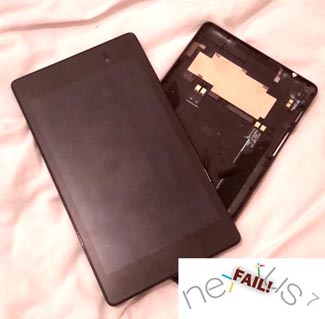 Nexus 7 2013 Dead Compass & Sensors
Nexus 7 2013 Dead Compass & Sensors
Congratulations to Asus for making the Nexus 7 (2013, 4g) out of the finest warrantanium™ known to man. Precisely timed to fail at 13 months of ownership, the device suffered a series of failures in the hope that “ooh look it’s broken, I’ll fork over another ~$500 in bad-design-tax!” is what customers will say. Errrr – no.
Cheap Cabling and Bad Implementation
The problem? Half of the sensors suddenly stopped working – these are crucial to me as the primary use for this thing was as an electronic mapping system to help me find my way around London. GPS still worked but the rotation sensors (that rotate the image when you flip it sideways, etc.) and the compass were completely offline.
Staring down the barrel of a £330 bill for a new unit (going Samsung next time as my ancient Galaxy Tab 7” is still going strong) – I thought to look online for tech advice to see if this was a known problem. Oh yes people – it is, it’s common and it appears to be down to some shoddy materials and manufacturing decisions. You see a lot of these appearing on the market as “refurbished” units – I think I know why.
Realising that I had a very expensive and now largely useless device I figured that it would be worth seeing if there was any way to repair it as it was dead anyway; I found:
- Go to the android marketplace and download the app “Check my Android” by Wooram Hong – excellent straight forward testing app. https://play.google.com/store/apps/details?id=com.checkmyandroid.app
- Click the “compass” item and if it’s fixed (not moving around) it’s probably the sensor in my case
- Select the “sensors” button – you will see a series of sensors listed but if this isn’t working properly (as it wasn’t in mine) then sensors 1, 5 and 7 will be missing from the list. When you move the tablet around the numbers in the circles on that page will also not move (img https://lh4.ggpht.com/4x7otGI9ZAEPdHWZYk7DD677tWbaynR3lnMHbkobEudp6nhtnso_1kdC3L428jI1lwE=h900-rw)
- I tried putting some pressure on the back of the tablet as mentioned here - http://www.androidauthority.com/nexus-7-2013-problems-524510/ This did nothing unfortunately but it’s worth a try as if it works you won’t have to take the tablet apart...
- I then followed the visual instructions in this link: http://www.youtube.com/watch?v=mG6MQU3jTVI
This shows you how to:
-
- Take the tablet apart (rather hair raising but can be done with finger nails, some plastic wedges and patience/care; I used a piece of leather to help wedge the back off and unclip it too)
- Locate and unplug a cable that connects two boards inside the device
- Clean the connectors on this cable (corrosion on its connectors appears to be the problem, they look like tin; they should use gold here to avoid this type of problem)
- Re-connect the cable (this is much harder than it looks, you have to edge it into place then slide/plug it into the tiny connector)
- The guide also shows you how to further brace the cable with some additional padding material
Power up the tablet and re-run the testing app – if it was successful you should once again see the compass work and all of the sensors should appear in the list – the numbers will change as you change the orientation of the device.
Oh and also screen rotation should now work (presuming you have it enabled) so when you flip it to portrait or landscape it should adjust accordingly.
Additionally these kind people have done a “teardown” of the device too - https://www.ifixit.com/Teardown/Nexus+7+2nd+Generation+Teardown/16072